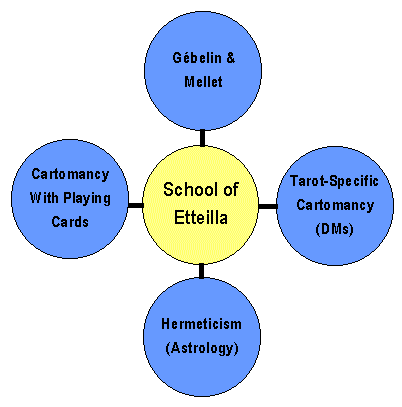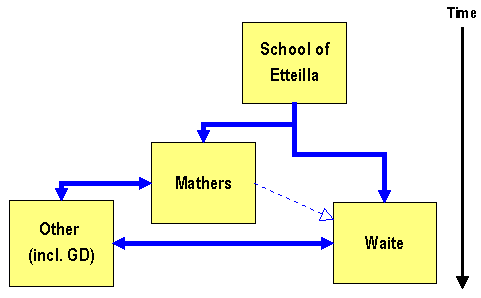DISCUSSION & IMPLICATIONS THE SCHOOL OF ETTEILLA’S PIVOTAL ROLE Results of this and prior studies (e.g., Decker, Depaulis & Dummett, 1996) help to place Etteilla and his school in historic context more accurately. Specifically, one may reasonably argue that Etteilla and his school played a pivotal role in the development of the esoteric Tarot by placing itself at the center of a system comprised of:
- The theories of Gébelin and Mellet and extensions thereof;
- Hermeticism (including astrology);
- Cartomancy with playing cards; and
- Tarot-specific cartomancy, which included DMs (see Figure 11).

Figure 11: The School of Etteilla’s role in the development of the esoteric Tarot.
THE SCHOOL OF ETTEILLA’S
INFLUENCE ON MATHERS & WAITEIn turn, the SE significantly impacted Mathers and Waite. Specifically, it strongly influenced: (a) Mathers’ DMs for the Minor Arcana and (b) Waites’ DMs for the Major Arcana, Minor Arcana, and selected card combinations. In turn, through Mathers’ and Waite’s books and these authors’ involvement in the other esoteric movements (including the GD), the SE influenced numerous occultists, including practitioners of Tarot. (For a brief look at the SE’s influence on contemporary practitioners of Tarot see Appendix E.) The results of this study also show that Mathers had a modest influence on Waite’s DMs, especially those of the Major Arcana. One may view these influences as a system unfolding over time (see Figure 12).
Figure 12: The School of Etteilla’s Influence on Mathers & Waite.
Interestingly, although popular contemporary authors (e.g. Giles, 1992; Wang 1978, 1987) often cite (and justifiably so) the GD as a major influence on Tarot theory and praxis from the late 19th century on, they give little if any credit to Etteilla. Yet, Mather’s The Tarot (1888/1993) and Waite’s PKT (1911), which continue to influence contemporary Tarot theory and praxis, depend to a significant extent from the SE. In fact, one may reasonably argue that Waite’s approach to Tarot, as revealed in the text of PKT, was as much a product of the SE and it was of the GD. Perhaps the time has come for scholars and popular authors to re-evaluate Etteilla’s impact on contemporary theory and praxis.
CONTEMPORARY SCHOLARS & PRACTITIONERS Although the SE arguably played a vital role in the development of the esoteric Tarot and continues to exert influence today, apparently most contemporary scholars and practitioners rarely if ever study or consult the works of Etteilla and his school. For those whose only language is English (and they presumably comprise an enormous number worldwide), these works were inaccessible; they have never been translated into English. However, the situation has changed with the publication of a portion of the SE’s corpus in English translation in Tarot Divination: Three Parallel Traditions (Papus, Mathers & Waite 1888, 1909, 1911/2000). English-speaking practitioners and scholars, apparently for the first time, now have relatively easy access to DMs from the SE. This ease of access, coupled with this study and others, may place English-speaking scholars in a better position to assess the SE. It may also place English-speaking practitioners in a better position to study and apply DMs from the SE. Arguably the time is ripe for scholars to conduct further research into the SE, and practitioners to re-discover and re-claim the SE as an integral part of their heritage.
WAITE’S LACK OF OBJECTIVITY & CANDOR This study also demonstrated the importance of studying primary sources, i.e., works produced by the SE. Unfortunately, due to the frequent unavailability of these works, many scholars and practitioners have presumably relied on secondary sources authored by occultists who clearly lacked objectivity. For example, one the least objective was Waite’s PKT (1911), wherein the author derided Etteilla’s achievements and mounted ad hominem attacks. In the bibliography, he takes the opportunity not to acknowledge Etteilla, but, as previously noted, to denounce his literary output as “colportage” (mere peddling or hawking) (p. 321).
As a result, a casual reader might conclude that Etteilla contributed little to Tarot and was not among Waite’s major sources. However, as this report shows, apparently nothing could be further from the truth. His many accomplishments notwithstanding, Waite clearly lacked objectivity and was less than completely candid with regard to his indebtedness to Etteilla. Unfortunately, Waite’s propaganda and that of similarly minded occultists (e.g. Lévi, 1854-55/1910; 1860/1913), have helped to perpetuate the false notion that Etteilla and his school contributed little to Tarot beyond popularization. Therefore, scholars and practitioners who wish to research or study the SE, would be wise to include primary sources, which depend from the SE, in their readings.
LIMITATIONS Risks of Generalizing
Generalizing findings presented here is risky. For example, for someone to say, without conducting further research, that the SE significantly influenced DMs from sources other than Mathers’ The Tarot and Waite’s PKT would be unwise. For someone to conclude that the SE was a major source for Mathers’ and Waite’s views on Tarot in general would also be unwise; this study only analyzed one aspect of their views, DMs.
Assessment of Methodology
The methodology of this study, although eminently practical, does have notable drawbacks. Only one individual, the author, translated the source materials from French. Additionally, only one judge, the author, compared DMs. Other individuals might have translated the source materials somewhat differently. Additionally, other judges might have reached different conclusions upon comparing DMs. Should a similar study ever be conducted, one may wish to use multiple translators and a panel of judges to help ensure the validity of findings.
Another drawback of this study is its reliance on only a small part of the output of Etteilla and his school, i.e., selections from Papus’ Le Tarot divinatoire (1909). Although such reliance was eminently practical because most of the SE’s output remains out of print, should a similar study ever be conducted, one may wish to use additional sources from the SE.
SUGGESTIONS FOR FUTURE
SCHOLARLY & PRACTICAL WORKResults of this study suggest the need for additional scholarly work, including publication of translations of the output of the SE. Additionally, re-publication of works from the SE in French, preferably with scholarly commentary, is also indicated.
Further related research remains to be conducted to answer numerous questions, a selection of which follows.
- In addition to DMs, did the SE significantly influence Mathers’ and Waite’s views of Tarot in other ways?
- Why did Mathers and Waite apparently use some DMs from the SE and reject others?
- Other than their The Tarot and PKT, which works, if any, by Mathers and Waite did the SE significantly influence?
- Which other collections of DMs, if any, has the SE significantly influenced? For example, has it significantly influenced DMs found in such contemporary sources as those of Gray (1960, 1970, 1971) and Pollack (1997)?
- Precisely which sources did the SE use to develop its DMs?
- Approximately one half of Mathers’ The Tarot and Waite’s PKT are apparently not derived from the source authorities chosen for this study. Where did they come from?
CONCLUSION The subject of this study has been the influence of the eighteenth-century French occultist Etteilla and his school on Mathers and Waite. Results have shown strong support for the idea that the SE significantly influenced the DMs suggested by both Mathers and Waite. They also showed modest support for the idea that Mathers influenced Waite’s DMs.
Results of this and other studies imply that the SE played a pivotal role in the development of Tarot. In light of this, scholars may wish to study the SE in greater depth to evaluate further other contributions, if any, which it has made. Additionally, practitioners may wish to study the output of the SE and apply what they learn to enrich their use of Tarot.
NEXT PREVIOUS CONTENTS REFERENCES E-MAIL AUTHOR HOME
Copyright © 2000 James W. Revak. All rights reserved. Version 1.0 (2/11/00).
